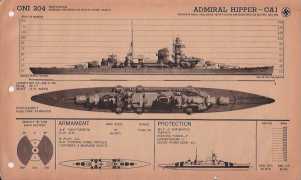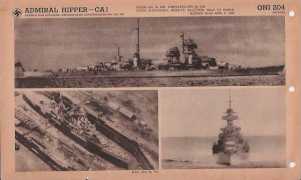Admiral Hipper
German Heavy Cruiser of WW2
By Stephen Sherman, June, 2011. Updated March 1, 2012.
The lead ship of the class performed so poorly at the Battle of Barents Sea that she caused Hitler to beach all the Kriegsmarine's large surface ships. The Hipper class of heavy cruisers were first begun in 1935 and served throughout World War Two.
Description of Class
In profile, they resembled the Bismarck class battleships, with a flush deck, two forward turrets, bridge and conning tower, a single funnel, a catapult area, then a radio mast, and two after turrets. The Hipper class were 655 feet long overall, 639 feet 9 inches at the waterline, with a beam of 69 feet 11 inches and an average draft of 15 feet 5 inches. This length is from the 1943 USN Recognition Manual (USNRM). Other modern sources report a length of 675 or 697 feet. Displacement was 14,000 tons, although Germany officially reported them to be 10,000 tons, in compliance with the 1935 Anglo-German Naval Agreement and the 19030 Washington Naval Treaty.
Armament
Main armament consisted of eight 8-inch guns mounted in four twin turrets. These guns had a maximum elevation of 37° and a maximum range of 17,000 yards. (Again, the USNRM provided that estimate; other sources report a maximum range in excess of 30,000 yards.) The secondary armament was twelve 4.1 inch dual-purpose guns, as well as dedicated 37mm anti-aircraft guns. The class was equipped with twelve 21-inch torpedo tubes, mounted in triples, one pair near the conning tower, the other pair near the radio mast. For scout observation, three Arado Ar 196 seaplanes could be launched.
Protection
The USNRM estimated that the class had 4 inches of belt armor, 2 inches on the conning tower and range-finders, with 3¼ inches over the deck. Other sources report that the heaviest armor was around the conning tower.
Propulsion
Three Blohm & Voss steam turbines, generating 100,000 HP, drove three three-bladed propellers, enabling a top speed of 32.5 knots.

Operational Histories
There were 5 ships planned for the 1935 class: Admiral Hipper, Prinz Eugen, Seydltiz, Blücher, and Lützow, but the last two were never completed.
Admiral Hipper
She was commissioned on April 29, 1939 and underwent sea trials in that last summer before the war, visiting Sweden and other Baltic ports. From November, 1939 through January, 1940, she was in the Hamburg shipyards, being fitted with a funnel cap and having a sleeker "Atlantic bow" installed. After another shake-down cruise in the Baltic Sea, she was deemed ready for active duty with the fleet in February, and patrolled the North Sea with Scharnhorst, Gneisenau and several destroyers.
Operation "Weserübung"
The German high command began planning for the invasion of Norway and Denmark in the winter of 1939-40. Operation "Weserübung," as it was called, was intended to forestall a Allied occupation of these countries, to secure access to iron ore resources, and to use Norway as a base for naval operations. Set for April 8-9, a key feature of the plan was to embark the troops on fast warships, rather than ordinary troop transports, to permit simultaneously occupation of several coastal cities. Thus, the unusual photographs at left of army troops getting on and later disembarking from Admiral Hipper.
As the German landing force (Admiral Hipper and destroyers Bernd von Arnim and Hans Lüdemann) made it's way toward the northern city of Trondheim on the foggy early morning of April 8, 1940, they encountered the British destroyer HMS Glowworm. Glowworm identified her enemies first and got in the first salvoes. The German destroyers called on the heavy cruiser for assistance, which opened up with her main 8-inch guns at 9:58 at a distance of 9,2000 yards. In a few minutes, the radar-guided guns found the range, and hit Glowworm with the fourth salvo. Damaged, Glowworm began making smoke in an attempt to hide from the German guns, but with radar, the shells kept hitting home. Within minutes, she had taken hits in the radio room, the bridge, the forward 4.7 inch gun, the engine room, and the mast. Glowworm fired a spread of torpedoes when less than 900 yards away, but missed, as the Admiral Hipper's bow was pointed directly at her. Meanwhile, Glowworm's smoke was everywhere. Suddenly Glowworm appeared, and rammed Admiral Hipper, a bold, but self-defeating move, as the heavy cruiser was only lightly damaged, but the destroyer's bow broke off completely and she sank. The British captain, Lieutenant Commander Gerard Roope, was awarded a posthumous Victoria Cross for his actions.
Damaged as she was, Admiral Hipper returned to Wilhelmshaven for repairs, which were completed by June.
Operation Juno
In June, 1940, a German task force consisting of Scharnhorst, Gneisenau, Admiral Hipper, and supporting destroyers raided British convoys off Hastad, Norway, sinking a troop transport, an oil tanker, and a sub-hunter.
From August to October, 1940, she was laid up for repairs, first in Wilhelmshaven, then in Hamburg.
Atlantic Raids
In the winter of 1940-41, in two cruises in the Atlantic, the Admiral Hipper enjoyed the largest successes of her career.




![Bundesarchiv, DVM 10 Bild-23-63-24 / CC-BY-SA [CC-BY-SA-3.0-de (www.creativecommons.org/licenses/by-sa/3.0/de/deed.en)], via Wikimedia Commons Bundesarchiv DVM 10 Bild-23-63-24, Schwerer Kreuzer "Admiral Hipper"](admiral-hipper-sea-trials-tn.jpeg)
![Bundesarchiv, Bild 101II-MW-1949-03 / Hipper / CC-BY-SA [CC-BY-SA-3.0-de (www.creativecommons.org/licenses/by-sa/3.0/de/deed.en)], via Wikimedia Commons Arado Ar 196 scout seaplane on catapult](arado-scout-seaplane-tn.jpeg)
![Bundesarchiv, Bild 101II-MW-5607-32 / Unknown / CC-BY-SA [CC-BY-SA-3.0-de (www.creativecommons.org/licenses/by-sa/3.0/de/deed.en)], via Wikimedia Commons Admiral Hipper Operation Weserübung](admiral-hipper-operation-weserubung-tn.jpeg)
![Bundesarchiv, Bild 101I-757-0038N-11A / Lange, Eitel / CC-BY-SA [CC-BY-SA-3.0-de (www.creativecommons.org/licenses/by-sa/3.0/de/deed.en)], via Wikimedia Commons Admiral Hipper in Norway](admiral-hipper-norway-tn.jpeg)
![Bundesarchiv, Bild 101I-757-0037N-26A / Lange, Eitel / CC-BY-SA [CC-BY-SA-3.0-de (www.creativecommons.org/licenses/by-sa/3.0/de/deed.en)], via Wikimedia Commons Admiral Hipper landing troops](admiral-hipper-landing-troops-tn.jpeg)